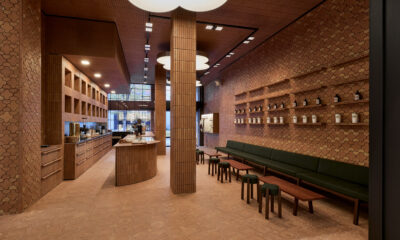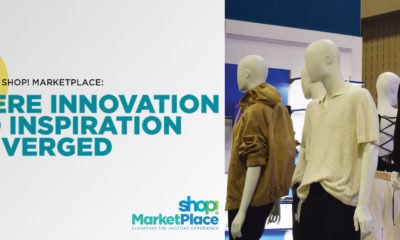Today's major brand retailers are jumping on the technology bandwagon. Now all that in-store technology has to function well.
To make sure it works, the more successful retailers are marrying design and technology. It's the only way they can achieve meaningful interaction with their customers. Since studies have shown that movement attracts the eye of a passerby, illuminated signage, multi-functional displays and lighting effects – the tools that produce greater motion – are being employed to lure shoppers inside and keep them in the store.
The newest, most-talked-about technology to enter the mainstream involves in-store digital media (also called digital marketing, digital signage, narrowcasting, digital in-store merchandising and electronic billboarding). Retailers have been exploring this technology for numerous reasons: to promote specific products, enhance the in-store experience, provide product information and as wayfinding systems.
Good objectives all, but digital media involve complex systems and great commitment on the part of the retailer. A digital system is complicated, composed of display screens, media players, IT infrastructure, mounting hardware, scheduling and management software and, of course (and not least), content. This relatively new technology is still expensive and somewhat cumbersome to integrate into the store infrastructure.
By routing TV-quality videos, audio, images and messages to in-store plasma screens, retailers are targeting specific demographics and matching promotions to shoppers' needs. Strategically placed digital projectors can “paint” images onto hanging signs and change them frequently. They can even project the latest fashions onto mannequins or project video onto glass and window displays.
Even traditional television – used in unconventional ways – can breathe life into a store. One cool new screen looks like a regular mirror – until a shopper approaches, when a motion detector triggers backlighting on what appears to be a two-way mirror, revealing an advertisement.
Return of the Kiosk
We're also witnessing the rebirth of the kiosk (the Edsel of the 1990s). Virgin Records recently launched a floor display where customers interact with a music video. Gesture-recognition software senses the interaction and projects interactive content.
Small, inexpensive micro point-of-purchase devices, attached to shelves, have pre-loaded advertising messages, both static and animated. Taking the concept one step further, micro tag players use new OLED (organic light emitting diodes) technology. These displays are thinner, brighter and have a 180-degree viewing angle for video and animations. This technology has also fashioned the next generation of name tags, so that staff can stand out from the crowd.
Electronic ink is a new product that uses charged particles printed onto a plastic film and layered to a sheet of circuitry. These pixels are then controlled by a display driver, which is charged by battery, about the size of a candy bar. The device can be used for shelf signage and menus, and can feature up to seven images. Touch-interactive or smart-shelf technology features a hardwire embedded into a shelf. As items are removed and replaced, audio and visual messages start up and speak to the customer.
Sound of Music
And let's hear it for audio. With the proliferation of iPods and satellite radio, retailers are easily customizing soundtracks or tuning to satellite-delivered music to give instant atmosphere to their stores. A remarkable product I've seen, called the audio spotlight or laser beam audio, projects an audio beam at any object, making it seem as though the object itself is producing the sound. It can be used to create distinct pools of sound targeted to individual shoppers as they linger in front of a product or display. And it doesn't disturb others in the immediate vicinity or increase the ambient noise in the area.
The videophone kiosk allows customers to record and send messages via email to family and friends. In a retail outlet, a woman can try on a dress and send a video to her husband to get his opinion. Or someone can email a friend about a gift purchase. The uses are limitless!
Out of the Fog
The Fogscreen projects an image onto a wall of fog from an overhead fog-making machine. The Interactive Floor, as seen at the O2 store in Munich, Germany, features a floor that looks like ice and sounds like ice cracking as you walk across it. (I've also seen this demonstrated as a puddle of water that you splash across or a bunch of balls that bounce as you step on them.)
If you've seen the Tom Cruise movie, “Mission Impossible III,” you've seen this product, in which projectors throw images onto glass or acrylic. This Canadian product brings high-quality web content into the retail environment on a large immersive platform. It can split the screen up into several sections, interactive in one area and non-interactive in another. It can be motion-sensitive, it can even be linked up to smoke machines, lighting and mechanical effects.
With the advent of RFID (radio frequency identification), forget about long lines at the check out. Roll your cart past the reader and the intelligent bar codes on your packages will talk to a networked system to identify every product. Then have your fingerprint scanned and funds are automatically transferred from your bank account to the retailer. Imagine your customers walking into a store without a wallet or credit card and walking out carrying a shopping bag!
Challenges and Hurdles
Is it all a panacea, without challenges? Is anything?!? Hope Remoundos, senior vp of sales and marketing at the Hudson News Co., has just installed a digital media program in her stores. She says delivering content to the stores has been difficult. The installer has been known to mount the satellite dish on the roof aimed the wrong way. And the plasma screen manufacturer's orders have gotten hung up in shipping. But she likes the fact that she controls all of the content from her home office in North Bergen, N.J., so she can test it in her test lab on site. She also sees that customers like interactive motion displays, so the company is getting ready to install its first interactive floor projection logos now.
But if your budget doesn't allow for all of this high-tech gadgetry, you can always construct your store out of raw titanium or you can build an upside-down store to attract attention, like Viktor + Rolf did in Milan. The possibilities, as always, are endless. Just be creative.
Rosi Rawson is an architect and assistant vp at TranSystems Corp. (Norwalk, Conn.), a retail consulting firm that specializes in the conceptualizing, design and construction of retail facilities in airports. She has over 13 years of retail design experience and has overseen the design and construction of almost 350 varied retail stores at over 40 airports and major transportation stations in the US and Canada.


 Headlines1 week ago
Headlines1 week ago
 John Ryan2 weeks ago
John Ryan2 weeks ago
 Headlines7 days ago
Headlines7 days ago
 Headlines2 weeks ago
Headlines2 weeks ago
 Headlines1 week ago
Headlines1 week ago
 Retail Buzz3 days ago
Retail Buzz3 days ago
 Headlines1 week ago
Headlines1 week ago
 Headlines1 week ago
Headlines1 week ago






